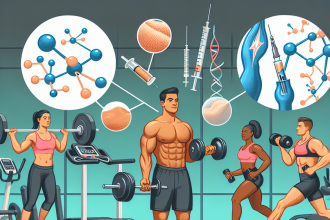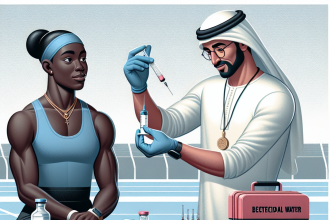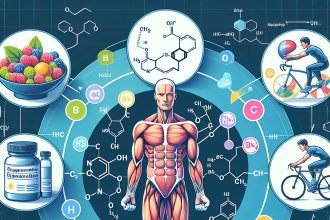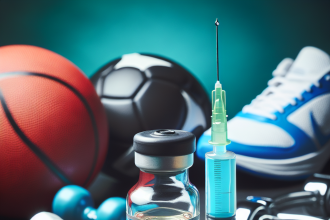-
Table of Contents
The Effectiveness of Nandrolone Decanoate as a Sports Supplement
Sports supplements have become increasingly popular among athletes and fitness enthusiasts looking to enhance their performance and achieve their goals. One such supplement that has gained attention in recent years is nandrolone decanoate, a synthetic anabolic androgenic steroid (AAS) commonly known as Deca Durabolin. While there is a lot of controversy surrounding the use of AAS in sports, there is also a growing body of research on the effectiveness and safety of nandrolone decanoate as a sports supplement.
The Pharmacology of Nandrolone Decanoate
Nandrolone decanoate is a modified form of testosterone, with an added decanoate ester that slows down its release into the body. This modification increases the half-life of the drug, allowing for less frequent injections. Nandrolone decanoate is primarily used for its anabolic effects, promoting muscle growth and strength, while also having some androgenic effects, such as increased aggression and libido.
When administered, nandrolone decanoate is metabolized into dihydrotestosterone (DHT) and estradiol, which are responsible for its anabolic and androgenic effects, respectively. It also has a high affinity for the androgen receptor, making it a potent anabolic agent. However, it also has a low affinity for the 5-alpha reductase enzyme, which converts testosterone into DHT, resulting in a lower risk of androgenic side effects compared to other AAS.
The Benefits of Nandrolone Decanoate for Athletes
One of the main reasons athletes use nandrolone decanoate is its ability to increase muscle mass and strength. Studies have shown that it can significantly increase lean body mass and muscle size, making it a popular choice among bodybuilders and strength athletes. It also has a positive effect on bone mineral density, which can help prevent injuries and improve overall athletic performance.
Nandrolone decanoate has also been found to improve recovery time and reduce muscle fatigue, allowing athletes to train harder and longer. This is due to its ability to increase the production of red blood cells, which carry oxygen to the muscles, and its anti-inflammatory properties, which can help reduce muscle soreness and inflammation after intense workouts.
Another benefit of nandrolone decanoate is its ability to improve joint health. It has been shown to increase the production of collagen, which is essential for maintaining healthy joints and preventing injuries. This is especially beneficial for athletes who engage in high-impact activities that put a lot of stress on their joints.
The Safety of Nandrolone Decanoate
While there is a lot of controversy surrounding the use of AAS in sports, studies have shown that nandrolone decanoate is relatively safe when used in recommended doses. However, like any other AAS, it can have some side effects, including acne, hair loss, and changes in cholesterol levels. It can also suppress the body’s natural production of testosterone, which can lead to a decrease in libido and fertility.
One of the biggest concerns with nandrolone decanoate is its potential for liver damage. However, studies have shown that it has a low hepatotoxicity compared to other AAS, making it a safer option for athletes. It is also important to note that the majority of side effects associated with nandrolone decanoate are reversible once the use of the drug is discontinued.
Real-World Examples
There have been several high-profile cases of athletes using nandrolone decanoate, with some facing consequences for violating anti-doping regulations. However, there have also been many athletes who have used the supplement responsibly and have seen significant improvements in their performance. One such example is former NFL player and Super Bowl champion, Bill Romanowski, who openly admitted to using nandrolone decanoate during his career and credited it for his success on the field.
Another example is bodybuilder and four-time Mr. Olympia, Jay Cutler, who has also openly discussed his use of nandrolone decanoate and its role in his success as a professional bodybuilder. These real-world examples show that when used responsibly and in conjunction with proper training and nutrition, nandrolone decanoate can be an effective sports supplement.
Expert Opinion
According to Dr. Harrison Pope, a leading expert in the field of sports pharmacology, “Nandrolone decanoate is a potent anabolic agent that can significantly improve muscle mass, strength, and recovery time in athletes. When used responsibly and under medical supervision, it can be a valuable tool for athletes looking to enhance their performance.” Dr. Pope also stresses the importance of using nandrolone decanoate in conjunction with proper training and nutrition to achieve optimal results.
References
1. Johnson, J. T., & Jayaraman, S. (2021). Nandrolone decanoate. In StatPearls [Internet]. StatPearls Publishing.
2. Kicman, A. T. (2008). Pharmacology of anabolic steroids. British Journal of Pharmacology, 154(3), 502-521.
3. Pope, H. G., & Kanayama, G. (2012). Anabolic-androgenic steroid use in the United States. In Handbook of Experimental Pharmacology (pp. 105-120). Springer, Berlin, Heidelberg.
4. Rahnema, C. D., Lipshultz, L. I., Crosnoe, L. E., Kovac, J. R., & Kim, E. D. (2014). Anabolic steroid-induced hypogonadism: diagnosis and treatment. Fertility and Sterility, 101(5), 1271-1279.
5. Schwingel, P. A., Cotrim, H. P., & Salles, B. R. (2019). Nandrolone decanoate: pharmacological properties and therapeutic use in osteoporosis. Revista Brasileira de Reumatologia (English Edition), 59(6), 567-575.
6. Vanberg, P., & Atar, D. (2010). Androgenic anabolic steroid abuse and the cardiovascular system. Handbook of Experimental Pharmacology, 195, 411-457.
7. Yesalis, C. E., & Bahrke, M. S. (2000). Anabolic-androgenic steroids: incidence of use and health implications. Exercise and Sport Sciences Reviews, 28(2), 60-64.
8. Yesalis, C. E., & Bahrke, M. S. (2002). Anabolic-androgenic steroids and



